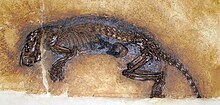Senckenberg Research Institute
The Senckenberg Research Institute was founded in 1817 by the Senckenberg Society for Nature Research in Frankfurt am Main . It forms an organizational unit with the Senckenberg Natural History Museum in Frankfurt am Main, the Senckenberg Museum for Natural History (Görlitz) , the Senckenberg Natural History Collections Dresden and the Senckenberg German Entomological Institute in Müncheberg.
description
One of the main tasks is to describe, understand and preserve biodiversity research under the motto of the diversity of life . As curators, the scientists at the research institute oversee the scientific collections of the research institute and evaluate them as part of their research projects. On research and collection trips as well as from local projects ( e.g. within the framework of the Taunusflora Working Group ), these collections are expanded by the scientists and voluntary assistants of the research institute.
The research projects go far beyond the core tasks of a research museum, which Senckenberg has long understood to be. Nevertheless, the scientists are still directly involved in the design and construction of the exhibitions and the permanent collection : after they have worked out a concept, it is implemented with the help of museum educators , taxidermists , graphic artists and marketing specialists . This is an attempt to keep the exhibition collections close to the current scientific status and at the same time to present them in an appealing and pedagogically well-thought-out way.
Since 2006, Senckenberg am Meer has been involved in the exploration of the German resource research area in the Pacific (Clarion-Clipperton fracture zone) of the Federal Institute for Geosciences and Natural Resources (BGR) . The aim is to extract mineral resources such as manganese and precious metals there later in deep-sea mining.
The Senckenberg Research Institute and Nature Museum is a member of the Leibniz Association . Its current general director is Volker Mosbrugger .
In addition to the three museums, the research institute also includes research stations in Wilhelmshaven (marine research, since 1928), Weimar (research station for Quaternary palaeontology , founded in 1962), in the Messel pit (paleontological research, since 1983) and in Gelnhausen (limnology and nature conservation research, since 2006 ). The institute is also involved in the research project The Role of Culture in Early Expansions of Humans .
In Frankfurt, both the previous main university building and the building of the physical association were renovated by 2019 and are now used by the research institute on a permanent basis.
The Senckenberg Research Institute is a member of BioFrankfurt , the network for biodiversity.
Research projects and collections
The scientists at the Senckenberg Research Institute look after special collections from the fields of zoology, botany, geology and palaeontology. A scientist as a section head and one or more technical staff are assigned to each collection. The main research areas are in particular:
- biodiversity
- Evolution and phylogenetics
- Evolution theory , especially the critical evolution theory (= Frankfurt evolution theory )
- Climate development
Senckenberg by the sea
The branch of the museum in Wilhelmshaven was founded by Rudolf Richter as early as 1928 . Senckenberg am Meer is the northernmost institute of the Senckenberg Association and consists of two departments: Marine Research and the German Center for Marine Biodiversity Research (DZMB). The head of the branch is André Freiwald . The oceanographic research institute cooperates u. a. with MARUM and the Institute for Chemistry and Biology of the Sea .
Gelnhausen branch
Since 1969 there has been a branch of the Senckenberg Research Institute in Lochmühle near Biebergemünd in Spessart. First of all, research was carried out here on the European low mountain ranges, in particular on their natural features and the different colonization by animals and plants. More recently, questions of water ecology and nature conservation research have come to the fore. In 2006 the branch moved to Gelnhausen.
Well-known scientists at the Senckenberg Research Institute and Nature Museum
- Eduard Rüppell (1794–1884), natural scientist and Africa explorer
- Georg Fresenius (1808–1866), doctor and botanist specializing in algae
- Otto Volger (1822–1897), natural scientist, geologist, mineralogist and politician
- Raphael Eduard Liesegang (1869–1947), chemist and writer
- Rudolf Richter (1881–1957), paleontologist
- Robert Mertens (1894–1975), biologist and director of the Senckenberg Research Institute and Natural History Museum in Frankfurt am Main
- Erich Triebel (1894–1971), paleontologist and micropaleontologist
- Tilly Edinger (1897–1967), paleontologist and the founder of paleoneurology
- Gustav Heinrich Ralph von Koenigswald (1902–1982), paleoanthropologist and geologist
- Wolfgang Struve (1924–1997), paleontologist
- Wolfgang Friedrich Gutmann (1935–1997), biologist, founder of the Frankfurt theory of evolution
- Jens Lorenz Franzen (1937–2018), paleontologist
- Manfred Grasshoff (* 1938), co-founder of the Frankfurt evolution theory
- Gerhard Storch (1939–2017), paleontologist
- Friedemann Schrenk (* 1956), paleoanthropologist, discoverer of the oldest fossil of the genus Homo
- Mena Schemm-Gregory (1976-2013), paleontologist


